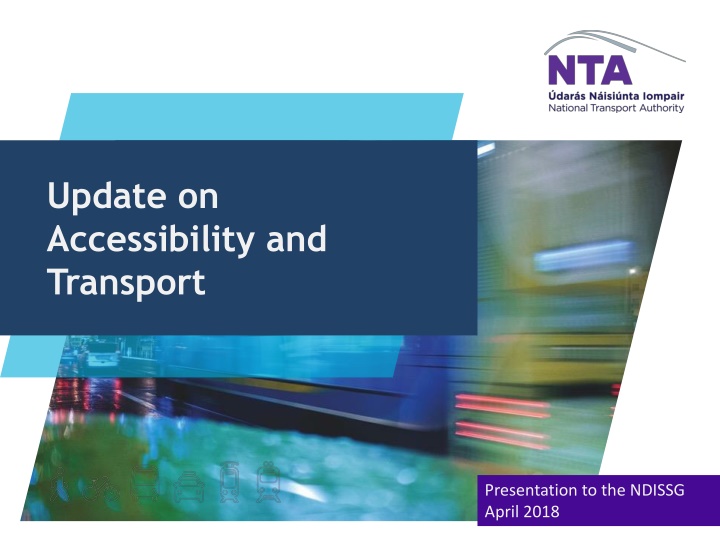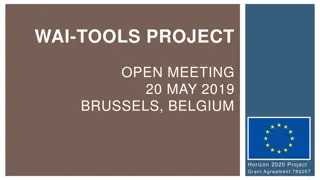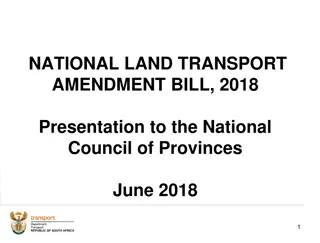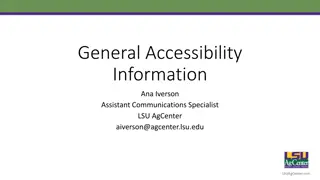Update on Accessibility and Transport Presentation to the NDISSG April 2018
Buses in Dublin and regional cities are fully accessible, with ongoing efforts to improve accessibility in coach fleets. Public transport services show progress in wheelchair accessibility, especially in city bus stops. Rail services have been designed to be fully accessible, with initiatives to enhance station accessibility. Taxi regulations prioritize wheelchair accessible vehicles, and rural transport programs are focusing on improving accessibility for all users. Various travel and service information enhancements are being implemented to support accessibility across different modes of transportation.
Download Presentation

Please find below an Image/Link to download the presentation.
The content on the website is provided AS IS for your information and personal use only. It may not be sold, licensed, or shared on other websites without obtaining consent from the author.If you encounter any issues during the download, it is possible that the publisher has removed the file from their server.
You are allowed to download the files provided on this website for personal or commercial use, subject to the condition that they are used lawfully. All files are the property of their respective owners.
The content on the website is provided AS IS for your information and personal use only. It may not be sold, licensed, or shared on other websites without obtaining consent from the author.
E N D
Presentation Transcript
Update on Accessibility and Transport Presentation to the NDISSG April 2018
Buses Dublin Bus Fleet is 100% accessible Regional cities fleet is 100% accessible 86% of coach fleet is wheelchair accessible, this will increase as the coach fleet is replaced 10% of public transport services are delivered by commercial operators licenced by the NTA. 16% of these services have low floor wheelchair accessible vehicles. A further 28% have vehicles with lifts suitable for wheelchair access All city bus stops are fully accessible where there is a hard standing at the stop Limited number of accessible bus stops in rural towns NTA, Bus ireann and CI are progressing a comprehensive programme of bus station upgrades
Light and Heavy Rail Services All of the Luas services have been designed to be fully accessible All of Iarnr d ireann Fleet fully accessible internally Advanced notice is required for ramp deployment on platforms. A pilot project to reduce the advance notice period from 24 to 4 hours is operating successfully since end of January 2018 118 of 144 stations on the Iarnr d ireann network have received accessibility upgrades or were constructed new to full accessibility standards. An accessibility audit in 2014 identified 54 stations that require enhancement. 22 of these have had works completed including Connolly station. 1 million has been allocated to this project in 2018.
Taxi Regulation Since 2010 the only new vehicle licences issued are for wheelchair accessible vehicles New regulations introduced in 2014 allow for smaller and less expensive wheelchair accessible vehicles to operate as taxis and hackneys WAV grant scheme has been operational since 2014. The number of WAV s in the fleet has increased from 860 in 2014 to 1,555 in 2017. 7.6% of the fleet are WAV s. Strict terms and conditions apply to the grant to ensure vehicles are used for intended purpose and disability awareness training is a condition of the grant. Training is provided free of charge by the NTA/IWA
Rural Transport Programme Local Link provides demand responsive door to door services for all including users with disabilities 38.7% of services are fully accessible and a further 22.9% are partially accessible Many of the services have passenger assistance on board All Local Link services are currently being retendered and will include a provision that all services must be fully wheelchair accessible within 2 years of contract award
Travel and Service Information Dublin Bus operates the Travel Assistance Programme across all modes PR/awareness campaign launched in October 2017 to prioritise wheelchair users on buses Don t buggy in the wheelchair space Real time arrival information is available for each stop on bus and rail services on web, smartphone app and sms messaging service Visual and next stop announcements available on all Dublin Bus and Bus ireann city services Next stop announcements audio and visual are available on all intercity and commuter rail services
Awareness Training and Support Disability awareness training is provided by all transport operators User groups have been established by all transport providers An accessibility officer has been appointed by each operator Quarterly progress report by NTA on actions to the department s accessibility consultative committee
What Needs to be Done Bus Fleet in conjunction with Bus ireann introduce low floor single deck vehicles to replace high floor coaches on services <50km NTA has commenced a full audit of existing infrastructure. NTA will continue to roll out the accessible bus stops programme on a route by route basis the aim being that all main towns have at least one wheelchair lift accessible bus stop in each direction Bus stations work closely with Bus ireann to ensure a comprehensive programme of station upgrades continues Publish proposals later this year which will set out minimum accessibility standards for commercial public transport services
What Needs to be Done Continue to fund accessibility upgrades at rail stations Next stop announcements on DART require a complete upgrade and scoping of this project has commenced. Upgrade DART in station information Continue to engage with disability user groups to enhance services across all modes























